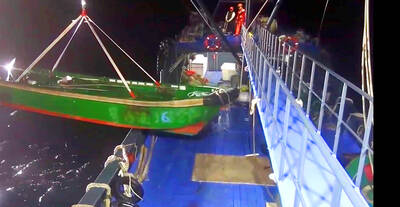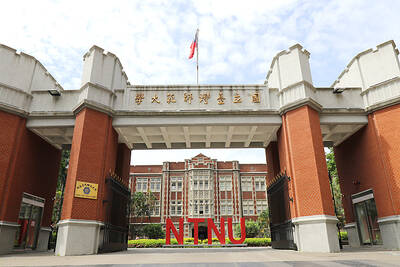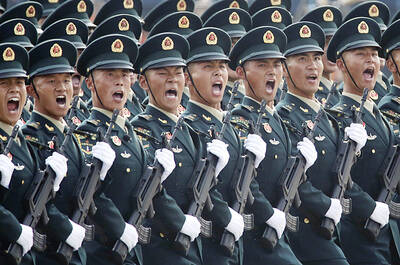The Hualien Gravel Industry Association urged the government to ease restrictions on dredging the county’s rivers to help prevent flooding as well as provide more work for gravel companies.
The association made the suggestion in the hope that the central and local governments would heed their call and save the gravel-mining industry.
Citing a government report, the association said gravel firms were only allowed to retrieve 60 percent of the 5.84 million cubic meters of gravel that accumulates each year in the rivers in Hualien County.
It said the restriction should be eased as the rapid accumulation of gravel in the county’s rivers was a serious problem.
The volume of gravel deposits in local riverbeds had reached 146.85 million cubic meters, it said.
This situation usually leads to riverbeds rising above ground level, raising the risk of flooding especially during the typhoon season when silt from landslides also piles up in riverbeds, the association said.
This was the second time the association had called for government assistance to help offset the difficulties it is facing.
The association said on Tuesday that the industry was facing an unprecedented crisis because of the global economic slump and the domestic quota on gravel. It said 80 percent of its 60 members in Hualien County had to send workers on unpaid leave, while 70 percent had been operating for only 10 days over the past three months.
It urged the authorities to allow Hualien businesses to mine more gravel to meet market demand, especially in the northern and western parts of the country, by relaxing the quota.
Prior to 2004, Hualien was exporting between 1.1 million and 1.3 million tonnes of gravel per month, and at least 11.2 million tonnes a year, it said.
About 60 percent of the gravel used in the Greater Taipei area used to come from Hualien, with China and other parts of Taiwan supplying 20 percent each.
However, since 2007, when strict caps on gravel exploitation in Hualien were imposed and the volume of imported gravel from China began to increase, the domestic industry has fallen on hard times, the association said.
It has suffered a fresh blow from the global financial crisis, which has resulted in Hualien County supplying only between 5 percent and 10 percent of the demand for gravel in Greater Taipei, it said.

Taiwan yesterday condemned the recent increase in Chinese coast guard-escorted fishing vessels operating illegally in waters around the Pratas Islands (Dongsha Islands, 東沙群島) in the South China Sea. Unusually large groupings of Chinese fishing vessels began to appear around the islands on Feb. 15, when at least six motherships and 29 smaller boats were sighted, the Coast Guard Administration (CGA) said in a news release. While CGA vessels were dispatched to expel the Chinese boats, Chinese coast guard ships trespassed into Taiwan’s restricted waters and unsuccessfully attempted to interfere, the CGA said. Due to the provocation, the CGA initiated an operation to increase

CHANGING LANDSCAPE: Many of the part-time programs for educators were no longer needed, as many teachers obtain a graduate degree before joining the workforce, experts said Taiwanese universities this year canceled 86 programs, Ministry of Education data showed, with educators attributing the closures to the nation’s low birthrate as well as shifting trends. Fifty-three of the shuttered programs were part-time postgraduate degree programs, about 62 percent of the total, the most in the past five years, the data showed. National Taiwan Normal University (NTNU) discontinued the most part-time master’s programs, at 16: chemistry, life science, earth science, physics, fine arts, music, special education, health promotion and health education, educational psychology and counseling, education, design, Chinese as a second language, library and information sciences, mechatronics engineering, history, physical education

The Chinese military has boosted its capability to fight at a high tempo using the element of surprise and new technology, the Ministry of National Defense said in the Quadrennial Defense Review (QDR) published on Monday last week. The ministry highlighted Chinese People’s Liberation Army (PLA) developments showing significant changes in Beijing’s strategy for war on Taiwan. The PLA has made significant headway in building capabilities for all-weather, multi-domain intelligence, surveillance, operational control and a joint air-sea blockade against Taiwan’s lines of communication, it said. The PLA has also improved its capabilities in direct amphibious assault operations aimed at seizing strategically important beaches,

‘MALIGN PURPOSE’: Governments around the world conduct espionage operations, but China’s is different, as its ultimate goal is annexation, a think tank head said Taiwan is facing a growing existential threat from its own people spying for China, experts said, as the government seeks to toughen measures to stop Beijing’s infiltration efforts and deter Taiwanese turncoats. While Beijing and Taipei have been spying on each other for years, experts said that espionage posed a bigger threat to Taiwan due to the risk of a Chinese attack. Taiwan’s intelligence agency said China used “diverse channels and tactics” to infiltrate the nation’s military, government agencies and pro-China organizations. The main targets were retired and active members of the military, persuaded by money, blackmail or pro-China ideology to steal